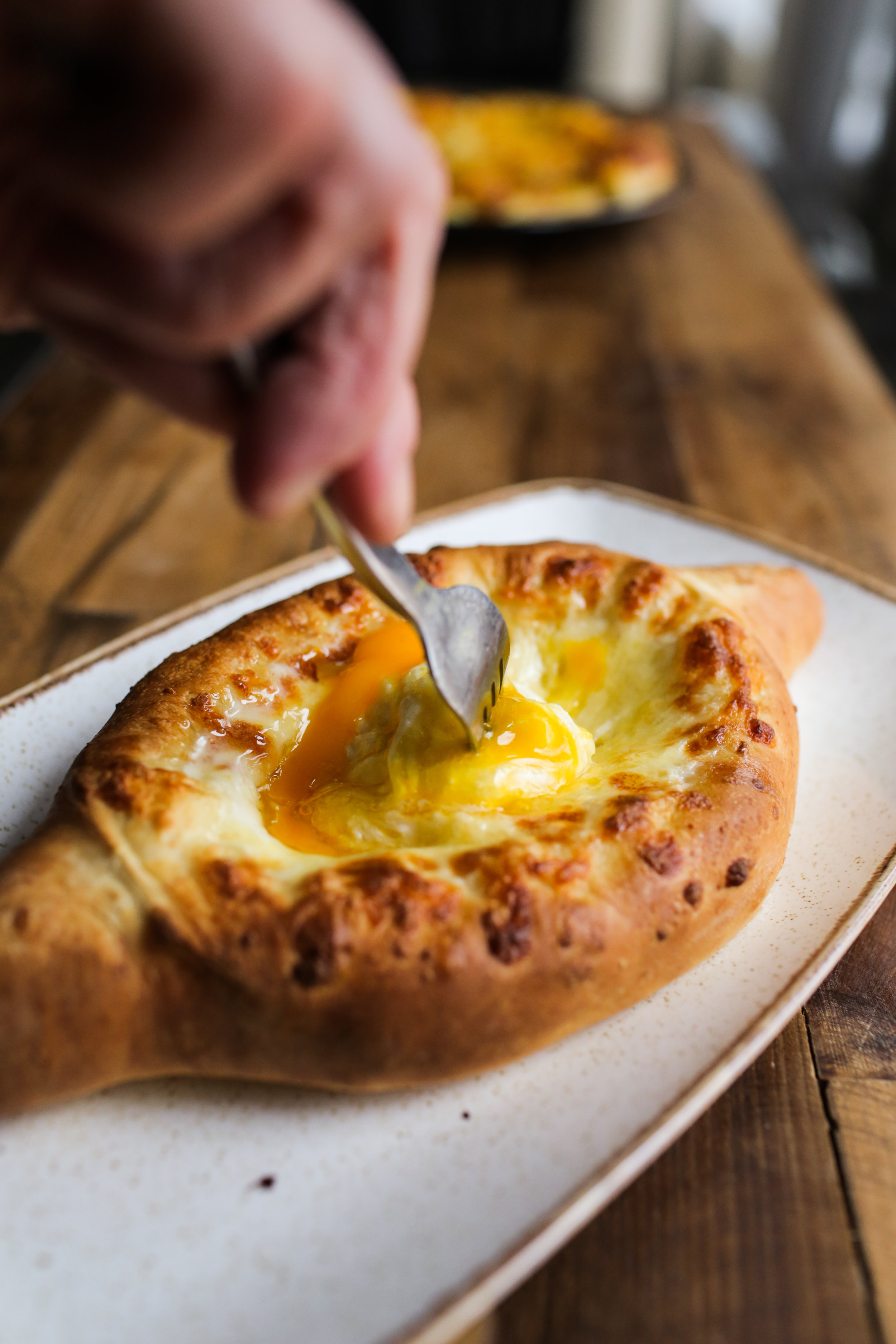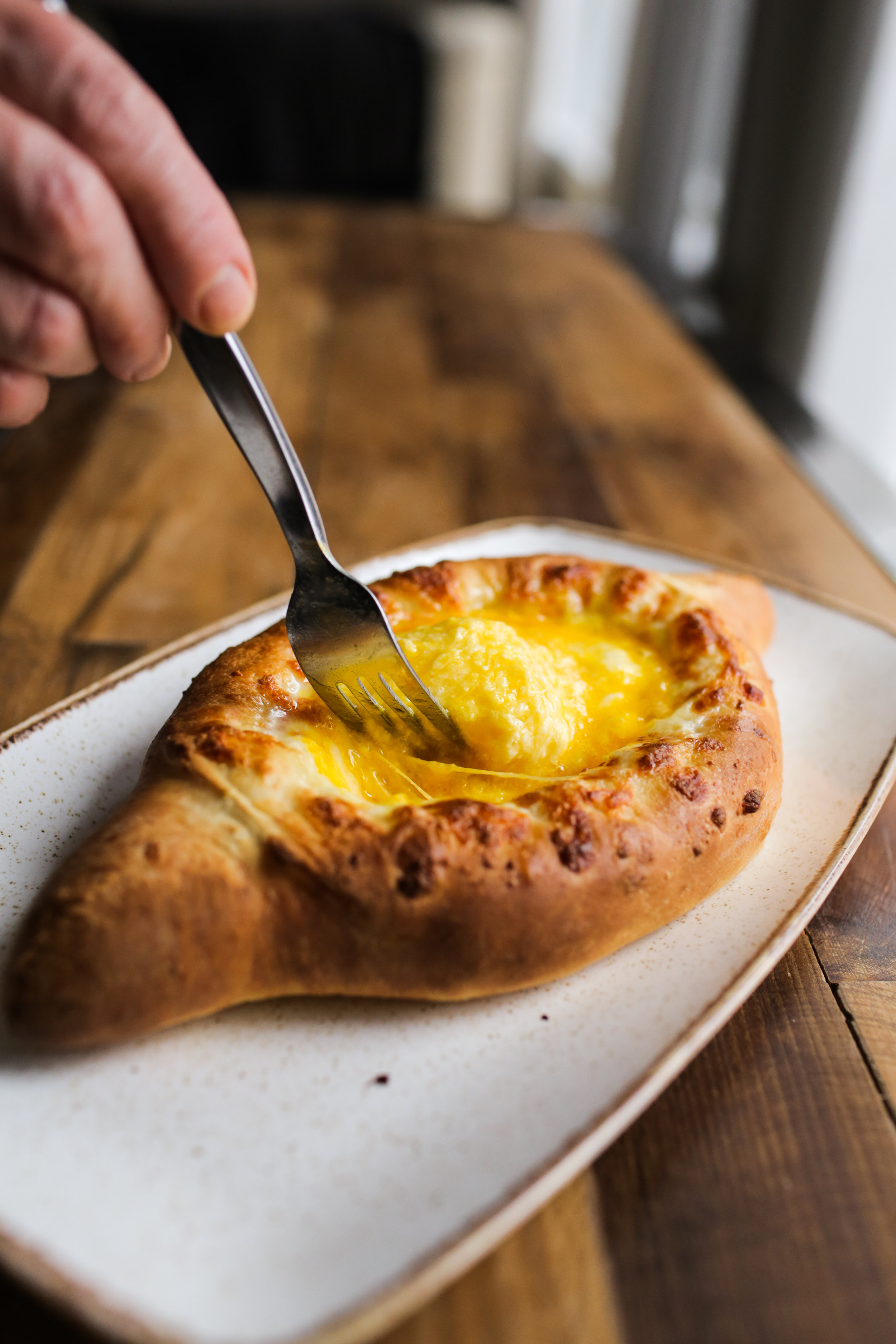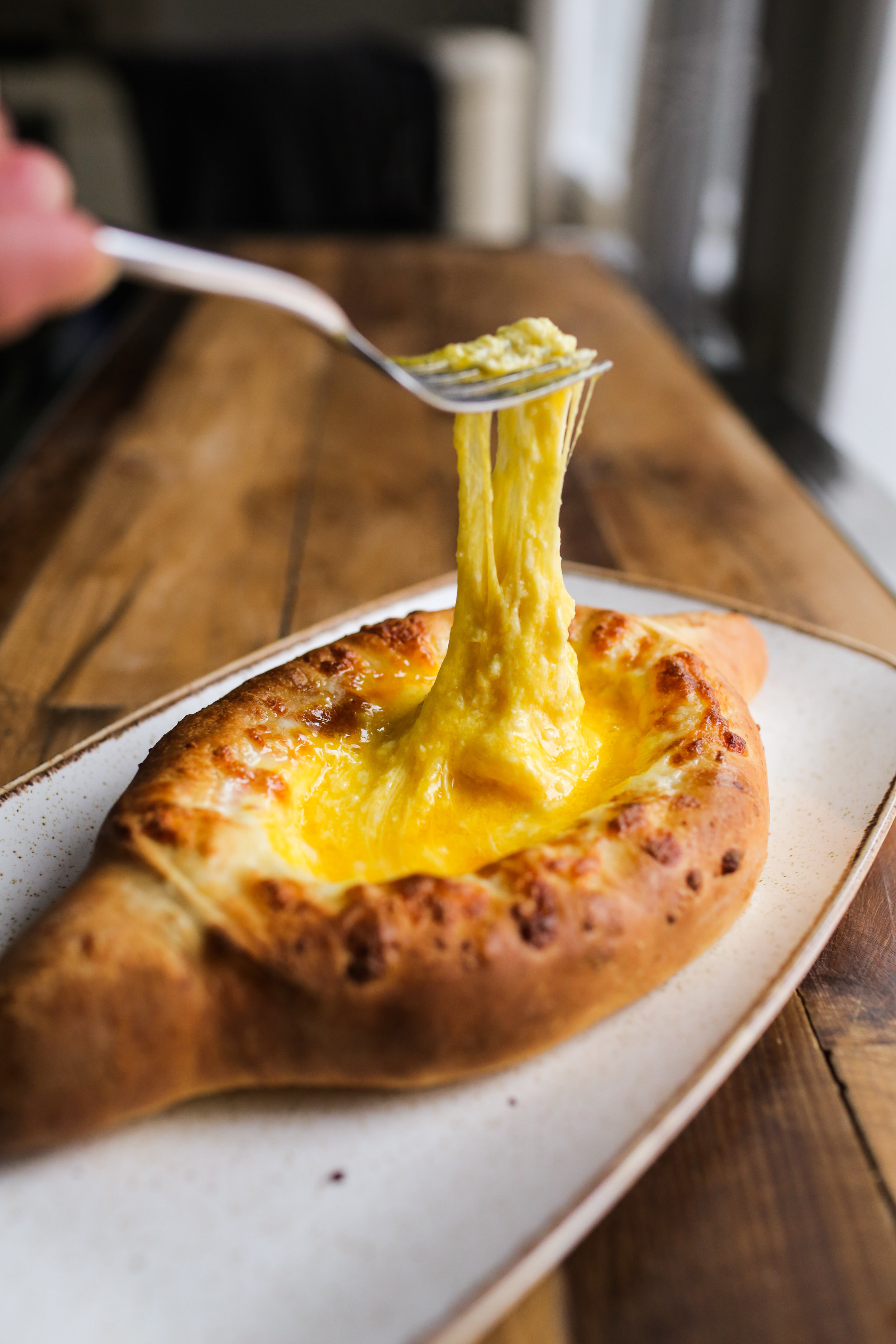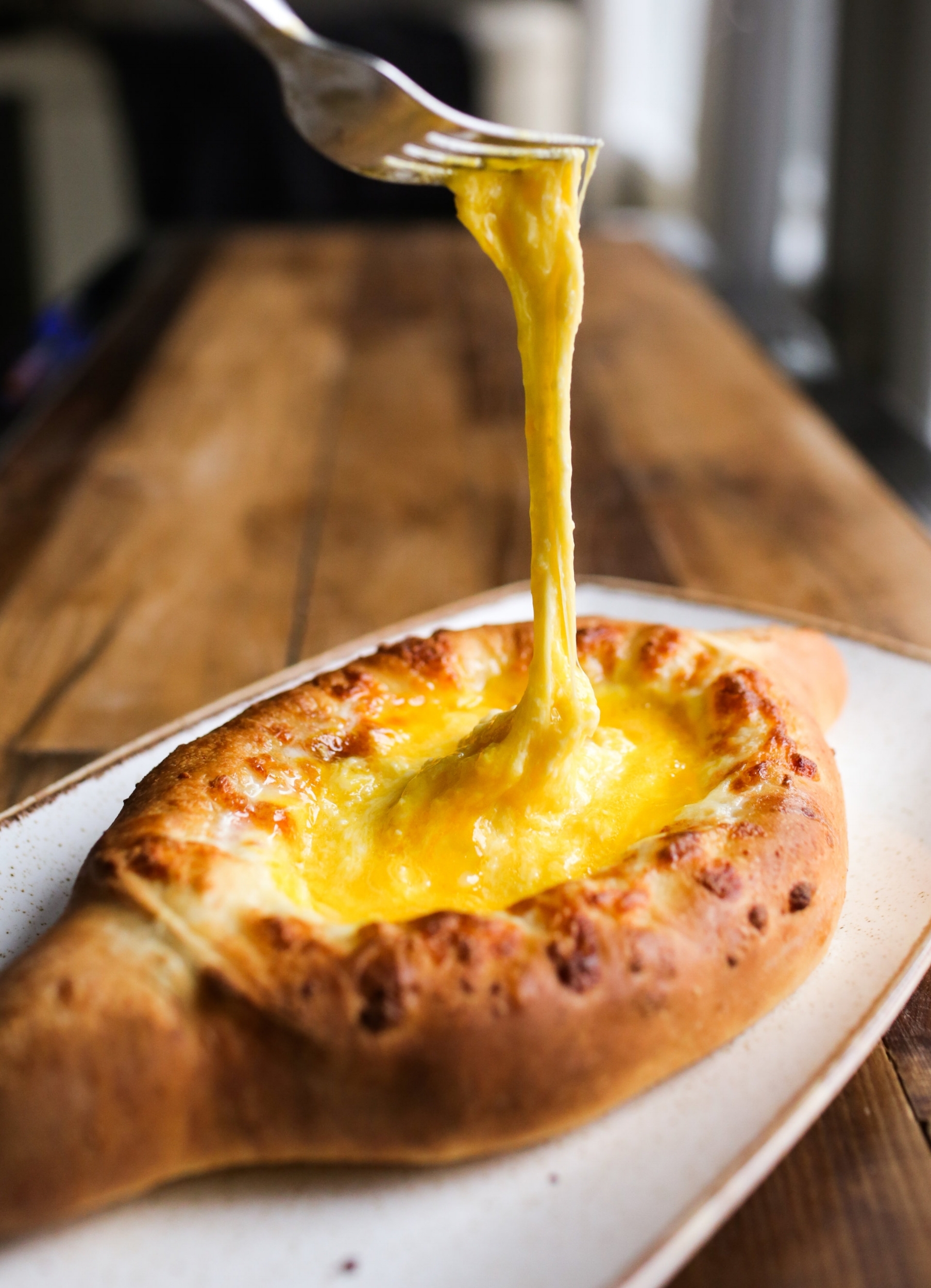Adjaruli Khachapuri
In February, I wrote Everything You Need to Know about Khachapuri for Culture magazine. I talked a little bit about its story and the culture that surrounds it (did you know the Georgians even have a Khachapuri Index to gauge inflation?) and listed a few of my favorite versions. I also promised you all a recipe for the Insta-famous Adjarian cheese boat, but deadlines and travel plans (aka Life) got in the way, and now here I am a month later finally addressing it.
A trio of khachapuri at a Tbilisi parlor devoted to the dish in July 2015.
As I noted in my article, this version of khachapuri hails from the region of Adjara on the Black Sea. Adjarians were historically great boat builders, so it was only natural for this coastal people to transform their bread into a vessel they could be proud of too. With cheese that represents the sea and a runny yolk the sun, their “lodachka” (little boat in Russian) is beloved throughout the country and now world.
This dish is hearty, indulgent and will warm you from the inside out—appropriate for those who, like me, still find themselves bracing against winter’s over-extended stay. But even if you’re already relishing in springtime bliss, Adjaruli khachapuri is a must try. Yes, I admit this khachapuri is a bit intimidating in look and size, and it would be easier to just leave it up to the professionals. But, unless you live in Brooklyn or D.C., you probably don’t have access to one. So, I insist you give it a go yourself. It really couldn’t be easier to prepare.
While you wait for the dough to rise, go read a book (I’m finally on Elena Ferrante’s fourth Neapolitan Novel and I can’t put it down), catch up on your favorite series (very into BBC’s Victoria and Netflix’s Dark these days), or invite some friends, open a bottle of wine, and make a fête out of it. They’ll provide moral support as you shape and fill your vessel, and keep you company as you crouch in front of the oven door, nervously watching the dough slowly rise and the filling turn molten.
Once out, your golden vessel will have you ooh and ahh. But beware, it has a way of sailing straight into your stomach, turning you into a cheese-filled boat yourself before you know it. You’ll get up from the table both thanking and cursing me and vow you’ve had your fill for months—that is, until you find yourself craving it a few days later… You’re welcome and bon appétit :)
Adjaruli Khachapuri
Makes 3 boats
Traditionally, this yeast-bread is filled with elasticy suluguni and fresh curd imeruli cheese. To approximate this filling, I use a combination of shredded low-moisture part-skim mozzarella (save your high-quality stuff for another dish) and briny feta. The yolk and pat of butter are a bit over the top, but are part of the experience. If you must, omit.
How to eat: break the runny yolk with a fork and swirl it into the pool of cheese and melted butter. To prevent overflow, lift the edges with one hand and push the mixture with your fork into the crevices. Once combined, tare off a tapered end and dunk it into the gluttonous mess you’ve created. Don’t feel compelled to eat it all at once (although recognize that you may and will)—it makes great leftovers reheated the next day.
For dough:
2 ½ cups (350 g) all-purpose flour, sifted, plus more as needed
1 teaspoon kosher salt
1 teaspoon sugar
1 teaspoon instant dry (or rapid-rise) yeast
1 cup water (235 ml), warmed
3 tablespoons sunflower or vegetable oil, plus more for greasing
For filling:
4 ounces (little less than 1 cup) feta cheese, crumbled or grated
4 ounces whole milk ricotta
12 ounces (3 cups) low-moisture, whole milk mozzarella, shredded
1 large egg
2 tablespoons water
1 teaspoon all-purpose flour
Assembly:
3 large eggs
A few pats of unsalted butter
For the dough: In a medium bowl, combine sifted flour, salt, sugar, and yeast. Make a well and add the warmed water and 3 tablespoons oil. Start out mixing with a wooden spoon then switch to using your hands once the dough is one mass. Knead until the dough is soft and tender, but elastic (a good test is to pinch the dough, and then pinch your ear lobe—you want it softer than your ear). If the dough turned out too wet, add a bit more flour; if it’s too dense, add a bit more water. Once done, pour some oil into your hand and greasing the sides of the bowl and form the dough into a ball. Cover with a damp clean kitchen towel and set aside to rest in a warm place.
After about a hour, or when dough has doubled in size, carefully grab an edge of the dough and stretch it over itself towards the opposite side. Repeat with remaining edges, turning the dough over, and gently forming it into a ball. Set aside for 30 minutes.
Meanwhile, to make the filling, in a medium bowl, mix the cheeses, egg, water, and flour until thoroughly hydrated and combined. Divide into three sturdy balls and set aside.
To assemble khachapuri, place an overturned rimmed baking sheet or pizza stone inside the oven and preheat it to 450°F degrees. Crack each egg into a separate small bowl. Cut parchment paper into three 5x8-inch pieces. Set aside.
Punch down the dough again and transfer it to a well-floured surface and divide in three. Take one piece, keeping the other two covered, and round it out gently with your fingers into a 4 to 5-inch circle. Use a rolling pin to gently roll it out to a 10-inch circle. Ideally, the sides will be thicker than the center. Take one edge of the circle and tightly roll it towards the center, about a third of the way. Repeat with the opposite side. Pinch the ends, twist them, pulling outwards as you do, and pinch them again to seal. Remember that you are creating a boat shape here. Lightly flour one of the parchment paper squares and place formed dough on top of it. Take one of the cheese balls, place it in the center of the cavity, and began to press it down lightly to spread and pack it evenly throughout the center. Repeat process with the remaining two pieces of dough.
Carefully remove the baking sheet from the oven (don’t do this if using a pizza stone). Holding on to the edges of the parchment paper, transfer the khachapuri to the baking sheet (or pizza stone). I can usually get two khachapuri to fit on one sheet.
Bake in the oven until dough is lightly golden brown and the cheese is melted, about 11 to 12 minutes. At this point, remove from oven and, working with one khachapuri at a time, carefully make a well in the cheese with a fork and slide an egg into it. Be careful not to break the yolk! Return to the oven and finish baking until the egg whites have set and khachapuri is a deep golden brown, about 3 to 4 minutes.
Remove the breads and place each on a serving plate. Top each with a pat of butter. Serve immediately!





